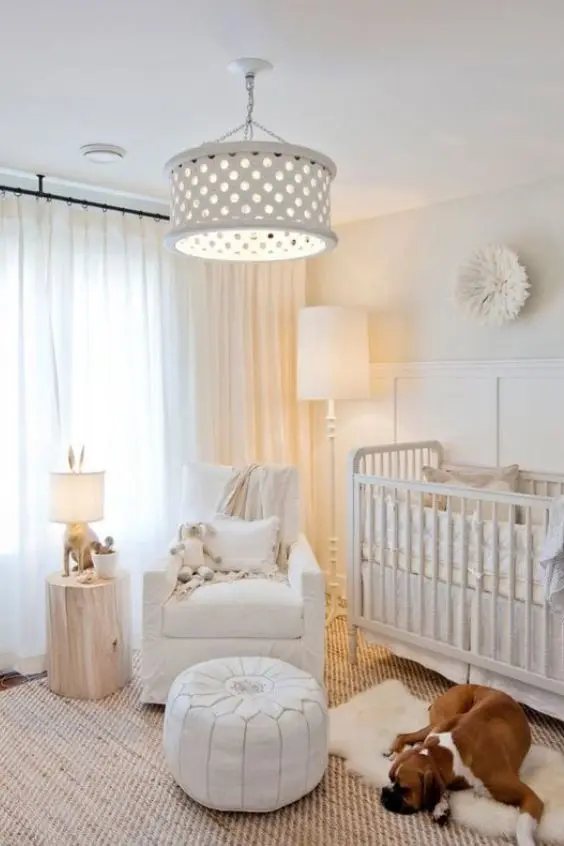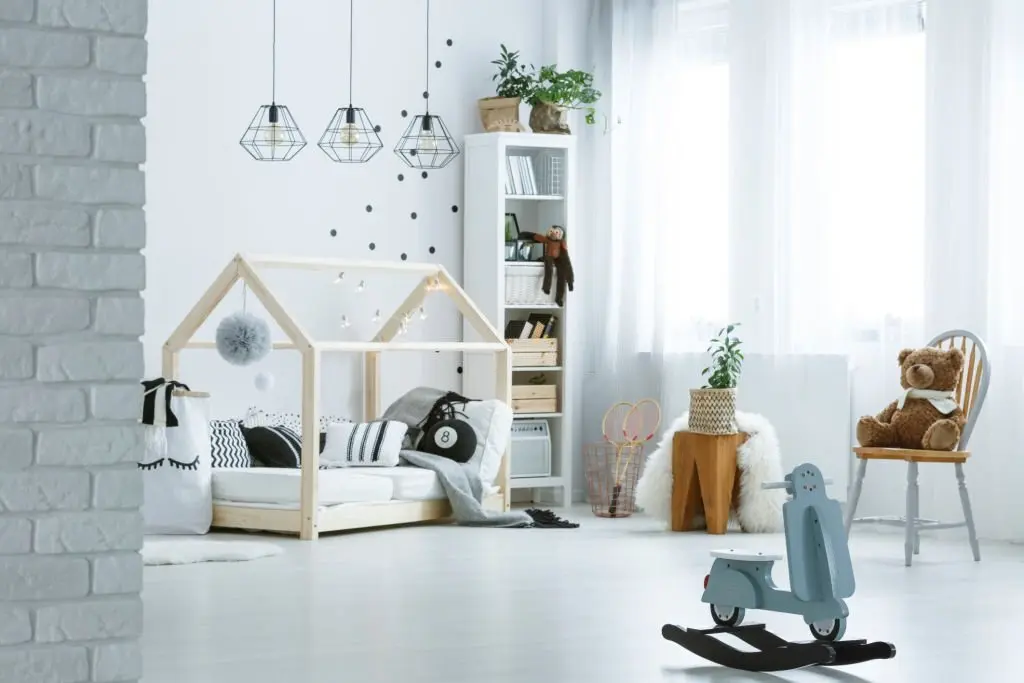Brilliant Ways to Brighten a Dark Nursery

Introduction to how do you brighten a dark nursery
Creating a nurturing environment for your little one is a task filled with love, care, and a fair bit of planning. One of the key aspects that can significantly impact the ambiance of your child’s nursery is its brightness.
So, how do you brighten a dark nursery? This comprehensive guide will walk you through the process, providing expert tips and insights on using colors, lighting, decor, furniture, and textiles to effectively illuminate your child’s space.
By the end of this guide, you’ll be well-equipped to transform a dark nursery into a bright, inviting, and stimulating environment that appeals to the eye and contributes positively to your child’s mood, behavior, and overall well-being. Let’s embark on this enlightening journey together!
Understanding the importance of a bright nursery
Why brightness matters in a Nursery
When it comes to designing a nursery, brightness plays a pivotal role. A well-lit room is visually appealing and child’s senses, promoting cognitive development. It’s also essential for practical reasons, such as changing diapers or feeding at night.
A bright nursery can make these tasks easier, reducing the risk of accidents like tripping over a toy or misplacing essential items. It also helps keep the room clean, as a well-lit room makes it easier to spot dirt or spills.
Moreover, brightness can significantly impact a child’s mood and behavior. A bright room can be invigorating and stimulating, promoting alertness and engagement with the surroundings. On the other hand, a dark room can be calming but may also induce sleepiness or lethargy. Therefore, striking a balance between brightness for stimulation and darkness for rest is crucial in a nursery setting.
The psychological impact of nursery lighting

Lighting can significantly impact mood and behavior. Research shows bright, natural light can boost mood, reduce stress, and improve sleep patterns. This is because light influences the body’s circadian rhythms, which regulate sleep-wake cycles, hormone release, and other bodily functions.
In the context of a nursery, exposure to bright light during the day can help regulate a baby’s sleep-wake cycle, promoting better sleep at night. Moreover, bright light can stimulate alertness and engagement, contributing to cognitive and visual development.
On the other hand, dim light can signal the body to prepare for sleep, promoting relaxation and sleepiness. Therefore, having control over the brightness in the nursery can help facilitate a healthy sleep-wake cycle for your baby.
So, how do you brighten a dark nursery? It’s all about understanding the interplay of colors, light, and decor. In the following sections, we will delve into these aspects in detail.
Choosing the right colors of baby room
The role of colors in brightening a room
Colors can dramatically affect the perception of space and light in a room. Light colors reflect light, making a room appear brighter and larger, while dark colors absorb light, making a room seem smaller and darker.
The choice of color can also influence the mood and atmosphere of the room. Light colors are often associated with positivity, cleanliness, and tranquility, making them ideal for a nursery. On the other hand, dark colors can create a cozy, intimate atmosphere but may also make a room feel gloomy if not balanced with adequate lighting.
Best colors for a nursery
When it comes to nursery ideas, opt for light, soothing colors. Pastels like baby blue, soft pink, mint green, or lavender are excellent choices. These colors are calming for babies and reflect light well, contributing to a brighter room.
Neutral colors like white, cream, or beige are also great options, as they provide a blank canvas that can be accented with colorful decor. These colors are timeless and versatile, allowing the room to evolve with the child’s changing tastes and needs.
However, avoid using bright, saturated colors as the main color scheme, as they can be overstimulating for babies. Instead, use them sparingly as accents to add pops of color and visual interest.
How to use colors effectively
To maximize the brightening effect, use your chosen color on the walls, ceiling, and even the floor if possible. Painting the ceiling a light color can reflect light downwards, enhancing the overall brightness of the room.
You can also incorporate color in the decor and textiles. For instance, you can choose bedding, curtains, rugs, and wall art in shades that complement the main color scheme. This creates a cohesive look and enhances the perception of brightness.
Remember, consistency is key to creating a cohesive, bright space. However, don’t be afraid to play with different shades of the same color to add depth and dimension. For instance, you can use a darker shade for the rug or curtains to ground the space and lighter shades for the walls and ceiling to enhance brightness.
Lighting the nursery

Types of lights for a Nursery
There are various types of lights you can use in a nursery. Ambient lighting, such as ceiling lights, provides overall illumination. This is the main light source that sets the tone of the room. Choose a bright, energy-efficient ceiling light with a dimmable feature so you can adjust the brightness as needed.
Task lighting, like table lamps or floor lamps, is useful for specific tasks like reading or changing diapers. These lights should be positioned where they provide targeted lighting without creating harsh shadows. For instance, a table lamp on the dresser can provide adequate light for changing diapers, while a floor lamp near the rocking chair can provide light for reading.
Accent lighting, such as fairy lights or LED strips, adds a touch of whimsy and brightness. These lights can be used to highlight decor or architectural features or simply to add a cozy, magical ambiance. They can also serve as a nightlight, providing a soft glow that is comforting for babies and practical for nighttime feedings or diaper changes.
Positioning lights for maximum brightness
To ensure the nursery is well-lit, strategically position your lights. Place task lighting near the changing table or rocking chair. Ambient lighting should be centrally located, and accent lighting can be used to highlight decor or architectural features.
Also, consider the direction of the light. Lights that shine downwards can create harsh shadows, while lights that shine upwards can enhance the perception of space and brightness. Therefore, a combination of both can create a balanced, well-lit space.
The role of natural light
Natural light is the best light. It’s not only brighter but also healthier. Natural light promotes the production of vitamin D, improves mood, and regulates circadian rhythms.
Make the most of windows by keeping them unobstructed during the day. Use light, sheer curtains that allow light in while maintaining privacy. If privacy is not a concern, you can even leave the windows bare to maximize natural light.
However, too much direct sunlight can be harmful, causing the room to heat up or damaging the skin and eyes. Therefore, use window treatments like blinds or shades to control the amount of direct sunlight entering the room.
Using decor to brighten the space
Choosing bright decor
Decor plays a crucial role in brightening a nursery. Choose decor items in light colors or with reflective surfaces. Items like white picture frames, light-colored toys, and shiny mobiles can all contribute to a brighter room.
Also, consider the size and placement of decor items. Large, dark items can absorb light and create shadows, making the room feel darker. On the other hand, small, light-colored items can reflect light and enhance brightness.
Moreover, the placement of the decor can influence the flow of light in the room. For instance, placing a shiny mobile near a window can reflect light into the room, enhancing brightness. Similarly, placing a light-colored rug in the center of the room can reflect light upwards, making the room feel brighter and larger.
The role of mirrors in brightening a room
Mirrors are a secret weapon when it comes to brightening a room. They reflect light, making a room seem brighter and larger. Place a mirror opposite a window to maximize the amount of natural light in the room.
However, be mindful of what the mirror reflects. A mirror that reflects a dark, cluttered corner can make the room feel darker and more cluttered. Instead, position the mirror to reflect a window or a light-colored wall to enhance brightness.
Also, consider the size and style of the mirror. A large, full-length mirror can reflect more light than a small, decorative mirror. However, a mirror with a light-colored or reflective frame can also contribute to the brightness of the room.
Using wall art to add brightness
Wall art is another effective way to add brightness. Choose pieces that are light-colored or have a reflective surface. You can also use wall decals in bright colors or metallic finishes.
The placement of wall art can also influence the brightness of the room. Hang wall art at eye level to draw the eye and create a focal point. Also, hang wall art on the wall opposite a window to reflect light and color into the room.
However, avoid overcrowding the walls with art as it can make the room feel cluttered and overwhelming. Instead, choose a few key pieces that complement the color scheme and style of the room.
The role of furniture in a bright nursery
Choosing the right furniture
When it comes to furniture, opt for pieces in light colors. White or light wood furniture will reflect light, contributing to a brighter room. Also, consider the size of the furniture. Large, bulky pieces can block light and make a room feel darker.
Choose furniture with clean lines and minimal detailing to enhance the perception of space and light. Also, consider furniture with built-in storage to reduce clutter and maximize floor space.
Moreover, consider the material of the furniture. Furniture with a glossy finish can reflect light and add brightness, while furniture with a matte finish can absorb light and make the room feel darker.
Positioning furniture for maximum light
The placement of furniture can also affect the brightness of a room. Avoid placing large pieces of furniture in front of windows or light sources. Instead, position them parallel to windows or against walls.
Also, consider the flow of the room. Arrange furniture in a way that allows for easy movement and does not block the flow of light. For instance, place the crib in a corner where it won’t block light from the windows or door.
The Impact of furniture color
The color of furniture can either enhance or diminish the brightness of a room. Light-colored furniture reflects light, while dark furniture absorbs it. So, choose your nursery furniture wisely.
If you have dark furniture, balance it with light-colored walls, rugs, and decor. Also, consider using throw pillows or blankets in light colors to break up the darkness of the furniture.
On the other hand, if you have light-colored furniture, you can play with color in the decor and textiles. For instance, you can use colorful bedding or curtains to add pops of color without compromising brightness.
Using textiles to add brightness
The role of rugs and curtains
Rugs and curtains can significantly impact the brightness of a room. Light-colored rugs and curtains reflect light, while dark ones absorb it. Also, rugs and curtains with reflective threads can add a touch of sparkle and brightness.
Rugs and curtains also contribute to the room’s overall color scheme and style. Therefore, choose rugs and curtains that complement the main color scheme and enhance the brightness of the room.
Choosing bright textiles
Opt for light colors and soft, reflective materials when choosing textiles for the nursery. Satin, silk, or velvet can add a touch of luxury and brightness. Also, consider patterns. Patterns with white or light backgrounds can add visual interest without compromising brightness.
However, avoid using too many different patterns, which can make the room feel chaotic and overwhelming. Instead, choose one or two key patterns and repeat them in different textiles to create a cohesive look.
How to use textiles effectively
To use textiles effectively, coordinate them with the room’s overall color scheme. Use them in moderation to avoid a cluttered look. Also, consider their placement. A well-placed rug or curtain can significantly enhance the brightness of a room.
For instance, a rug in the center of the room can reflect light upwards, making the room feel brighter and larger. Similarly, curtains that are hung high and wide can make the window appear larger and let in more light.
Maintaining a bright nursery
Cleaning tips for a bright nursery
A clean room is a bright room. Regular cleaning can prevent dust and grime from dulling surfaces and reducing light reflection. Also, clean windows regularly to ensure maximum natural light.
Use a microfiber cloth to dust surfaces and a glass cleaner for windows and mirrors. Follow the manufacturer’s cleaning instructions for textiles to prevent damage and fading.
Also, consider the air quality in the room. A room with fresh, clean air feels brighter and more inviting. Therefore, ensure good ventilation and consider using an air purifier or humidifier if needed.
The role of Clutter in room brightness
Clutter can make a room feel darker by blocking light and creating shadows. Keep the nursery tidy and organized to maintain its brightness. Use storage solutions like baskets and shelves to keep clutter at bay.
Also, consider the layout of the room. A room with a clear path and open spaces feels brighter and larger. Therefore, arrange furniture and decor to maximize open spaces and allow for easy movement.
Regular maintenance tips
Regular maintenance, such as repainting walls and cleaning light fixtures, can help maintain the brightness of the nursery. Also, replace burnt-out light bulbs promptly to ensure consistent lighting.
Consider the changing seasons and adjust the lighting and decor accordingly. For instance, during the darker winter months, you may need to add more lighting or use brighter decor to maintain the brightness of the room.
Also, as your child grows, their needs and preferences will change. Therefore, be prepared to adapt the room to suit their evolving needs while maintaining its brightness and appeal.
Conclusion on how do you brighten a dark nursery
Brightening a dark nursery is a multifaceted process involving carefully considering colors, lighting, decor, furniture, and textiles.
By understanding how these elements interact and influence the perception of light and space, you can transform a dark nursery into a bright, inviting, and stimulating environment for your little one. Remember, a bright nursery is not just about aesthetics; it also contributes to your child’s mood, behavior, and overall well-being.
Also Read
- Tips On How To Decorate a Nursery On a Budget
- 5 Things to Consider When Choosing a Glider or Rocker
- How to Choose the Right Baby Bedding
- 20 Beautiful Blue Nursery Ideas for Boys and Girls
FAQs on how do you brighten a dark nursery
How do you brighten a dark nursery?
Brightening a dark nursery involves a combination of choosing the right colors, lighting, decor, furniture, and textiles. Regular cleaning and maintenance also play a role.
What are the best colors for a bright nursery?
Light colors, especially pastels like baby blue, soft pink, mint green, and lavender, are ideal for a bright nursery. These colors reflect light well and create a soothing environment for the baby.
What types of lights are suitable for a nursery?
Ambient, task, and accent lights are all suitable for a nursery. Ambient lights provide overall illumination, task lights are for specific tasks like reading, and accent lights add a touch of whimsy and brightness.
How can decor contribute to a brighter nursery?
Decor can significantly brighten a nursery. Choose decor items in light colors or with reflective surfaces. Mirrors, wall art, and light-colored toys can create a brighter room.
What role does furniture play in a bright nursery?
Furniture plays a crucial role in a bright nursery. Light-colored furniture reflects light, contributing to a brighter room. The placement of furniture also matters; avoid blocking light sources with large furniture pieces.
How can textiles add brightness to a nursery?
Textiles can add brightness by reflecting light. Choose light-colored textiles and those with reflective threads. Rugs, curtains, and bedding can all contribute to a brighter nursery.
